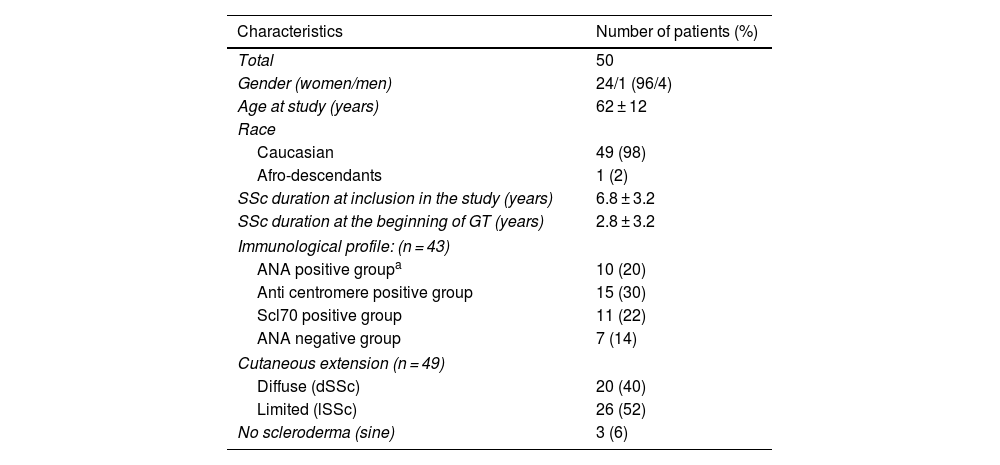The exposure to artificial gravity (AG) through human centrifugation is the basis of the treatment called gravity therapy (GT), in which the mechanical stimulation over the vessel wall, induces the synthesis and release of prostacyclin. It has been used for more than four decades in Uruguay in the treatment of different vascular-based pathologies. In patients with systemic sclerosis (SSc) it has shown good benefits and excellent safety profile over the years. However, there is a lack of knowledge in the scientific community about GT and its results.
ObjectiveTo evaluate the effectiveness of GT in cutaneous and vascular involvement, in the quality of life and functional capacity and its safety profile in patients with SSc.
MethodologyIt is a descriptive and retrospective study of patients with SSc assisted in an autoimmunity center in Montevideo, treated with GT in the last 10 years.
ResultsFifty patients were included, 48 women (96%) and 2 men (4%) with a mean age of 62 ± 12 years. The mean time of evolution of SSc at the time of inclusion in the study at the beginning of GT was 6.8 ± 3.2 years and 2.8 ± 3.2 years respectively. After GT, a significant improvement in the modified Rodnan skin score (mRSS) was observed (pre-GT 19.2 ± 8.7 vs. post-GT 5.4 ± 5.0, p < 0.05), which was not related to the time of disease progression at the beginning of GT nor to the skin extension or immunological profile. The degree of improvement post-GT was related to a higher initial mRSS (R = 0.84, p < 0.05). Also, a significant improvement was observed in the number of patients with puffy fingers (pre-GT 50% vs. post-GT 20% patients, p < 0.05), but not in telangiectasias, pitting scars or sclerodactyly. The severity of Raynaud's phenomenon significantly decreased (pre-GT: grade 3–4, 43/48 (89.6%) patients vs. post-GT: grade ≤2, 42/47 (89.4%) patients, p < 0.05) as well as the vascular pain measured with VAS (0–10 scale) (pre-GT: 7.6 ± 2.2 vs. post-TG: 1.4 ± 1.2, p < 0.05). The healing of digital ulcers was also recorded. Regarding the results reported by patients, 97% reported improvement in the quality of life and 89.5% improvement in the ability to carry out activities of daily living. No significant adverse effects were recorded.
ConclusionsGT improved cutaneous and vascular involvement, the quality of life and the functional capacity in patients with SSc with an excellent safety profile. Randomized, controlled clinical trials are needed to corroborate these observational results.
La exposición a la gravedad artificial (GA), a través de la centrifugación humana, constituye la base del tratamiento denominado terapia gravitacional (TG), mediante el cual se produce un estímulo mecánico sobre la pared vascular induciendo la síntesis y liberación de prostaciclina. Se usa desde hace más de cuatro décadas en Uruguay en el tratamiento de enfermedades de base vascular. En la esclerosis sistémica (ES) ha demostrado gran beneficio y excelente perfil de seguridad. Sin embargo, existe un desconocimiento en la comunidad científica acerca de la TG y de sus resultados.
ObjetivoEvaluar la eficacia de la TG en la afección cutánea y vascular, calidad de vida y capacidad funcional y su perfil de seguridad en pacientes con ES.
MetodologíaEstudio descriptivo y retrospectivo de pacientes con ES asistidos en un centro de autoinmunidad de Montevideo, tratados con TG en los últimos 10 años.
ResultadosSe incluyeron 50 pacientes, 48 mujeres (96%) y 2 hombres (4%) con una edad media de 62 ± 12 años. El tiempo medio de evolución de la ES al momento de inclusión en el estudio y al iniciar la TG, fue de 6.8 ± 3.2 años y de 2.8 ± 3.2 años respectivamente. Post-TG se observó una mejoría significativa del puntaje modificado de Rodnan (mRSS) (pre-TG 19.2 ± 8.7 vs. post-TG 5.4 ± 5.0, p < 0.05), que no se relacionó con el tiempo de evolución de la enfermedad al inicio de la TG, extensión cutánea o perfil inmunológico. El grado de mejoría post-TG se correlacionó con un mayor mRSS inicial (R = 0.84, p < 0.05). Se observó mejoría significativa del número de pacientes con puffy fingers (pre-TG 50% vs. post-TG 20% pacientes, p < 0.05), pero no en telangiectasias, pitting scars o esclerodactilia. La gravedad del fenómeno de Raynaud disminuyó significativamente, pre-TG: grado 3–4, 43/48 (89.6%) pacientes vs. post-TG: grado ≤2, 42/47 (89.4%) pacientes, p < 0.05, así como también el dolor vascular medido por EVA (escala 0–10) (pre-TG: 7.6 ± 2.2 vs. post-TG:1.4 ± 1.2, p < 0.05). También se registraron casos de curación de úlceras digitales. En cuanto a los resultados reportados por los pacientes, 97% refirieron mejoría en calidad de vida y 89.5% mejoría en capacidad para realizar actividades de la vida diaria. No se registraron efectos adversos significativos.
ConclusionesLa TG mejoró el compromiso cutáneo y vascular, la calidad de vida y la capacidad funcional en pacientes con ES con excelente perfil de seguridad. Se necesitan ensayos clínicos controlados y aleatorizados para corroborar estos resultados observacionales.















